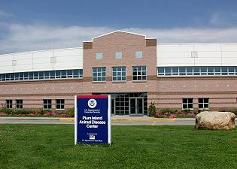
| Home | Information Sharing & Analysis | Prevention & Protection | Preparedness & Response | Research | Commerce & Trade | Travel Security | Immigration |

The threat level in the airline sector is High or Orange. Read more.


Since 1954, Plum Island Disease Center (PIADC) has been protecting America's livestock from foreign animal diseases (diseases not present in the United States) such as foot-and-mouth disease.
PIADC's mission can be grouped into three main categories:
As a diagnostic facility, PIADC is capable of diagnosing foreign animal diseases in addition to domestic animal diseases that may look like a foreign animal disease. PIADC runs between 22,000 and 35,000 diagnostic tests per year.
The facility's research programs include developing diagnostic tools and preventatives (such as vaccines and antivirals) for foot-and-mouth disease and other foreign diseases of livestock.
As an educational facility, PIADC has been instructing veterinarians in recognizing foreign animal diseases since 1971.
Because Congressional law stipulates live foot-and-mouth disease virus cannot be studied on the mainland, PIADC is unique in that it is the only laboratory in the United States equipped with research facilities that permit the study of foot-and-mouth disease.
Foot-and-mouth disease is an extremely contagious disease of cloven-hoofed animals. Accidental outbreaks of the disease have caused catastrophic livestock and economic losses in many countries throughout the world, most notably and most recently in the United Kingdom in 2001. Though foot-and-mouth disease was eradicated from the U.S. in 1929, it is currently endemic to many parts of the world.
A DHS Science and Technology Directorate Blue Ribbon Panel assigned highest priority to foot-and-mouth disease when considering high-consequence pathogens for study and development of necessary countermeasures because of its potential for severe economic and social impact as well as the devestation an outbreak could bring the United States.
The potential impact of an accidental or deliverate introduction of foot-and-mouth disease includes: production and export losses; cost of control through depopulation, disposal, vaccination, disinfection and surveillance; decreased consumption of feed products; allied industry losses (feed, equipment suppliers, veterinarians, etc.); and business interruption (tourism).
"The United States agriculture and food systems are vulnerable to disease, pest or poisonous agents that occur natually, and unintentionally introduced, or are intentionally delivered by acts of terrorism. America's agriculture and food system is an extensive, open, interconnected, diverse and complex structure providing potential targets for terrorist attacks. We should provide the best protection possible against a successful attack on the United States' agriculture and food system, which could have catastrophic health and economic effects."
Plum Island Animal Disease Center operates Biosafety Level 3 Agriculture (BSL-3Ag), BSL-2 laboratory facilities. PIADC has state-of-the-art biosafety practices and procedures to prevent a disease organism from escaping into the environment, including stringent and rigorously observed safety measures within the laboratories themselves. These safety measures include:
For more information about the lab, visit the PIADC Web site.
Plum Island Animal Disease Center
U.S. Department of Homeland Security
P.O. Box 848
Greenport, NY 11944
PIADC@dhs.gov
This page was last reviewed/modified on November 21, 2008.